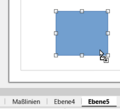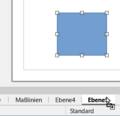Layer Functions in Draw
TDF LibreOffice Document Liberation Project Community Blogs Weblate Nextcloud Redmine Ask LibreOffice Donate
This page is in work!
Foreword
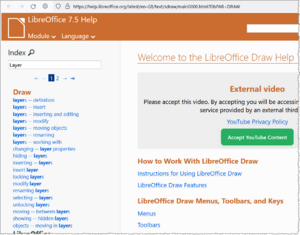
This video shows how "Layer Functions in Draw - LibreOffice" can be applied and links to this page here, which offers further information and details.
This discription is based on the LibreOffice online help:
Welcome to the LibreOffice Draw Help
Type "Layers" in the search bar to see the topics related to Layers.
Link to the Video
Link to the Video (in German [DE]):
Ebenen Funktionen in Draw - LibreOffice
Layer Functions

Layers in Draw allow great management even for more complex drawings.
Layers allow you to arrange related elements on a page.
For example, you can divide your drawing details according to whether or not you want them to be printed later.
You can make individual Layers invisible if too many details bother you when drawing.
And you can lock Layers so you don't accidentally edit objects you didn't want to.
Layers
LibreOffice Draw uses Layers to support you for your drawings.
The Layer selection is located below the plan window.
The areas on a Layer that do not contain objects are transparent.
Each Layer contains a so-called Drawing Layer.
The respective layer can be imagined as a transparent slide or drawing surface.
If you place several Layers on top of each other, the objects contained in them are displayed (prerequisite: the Layer is switched to visible).
The three Layers "Layout", "Controls" and "Dimension Lines", are always provided in Draw.
The Layout Layer is the default workspace.
The Controls Layer is for buttons that have been assigned an action and should not be printed.
Deactivate the "Printable" property of the Layer.
The Dimension Lines layer is used to draw dimension lines.
By changing the Layer, you can easily turn these lines on and off to hide or show them.
Select Insert Layer to add your own Layers.
Select a Layer
Select a Layer by clicking the tab with the Layer name at the bottom.
Stacking order
Except for the Controls Layer, which always comes before other Layers, Layers do not affect the stacking order of objects on a page.
The stacking order of objects on your slide is determined by the order in which you add the objects.
Choose ▸ from the menu to change the stacking order of objects.
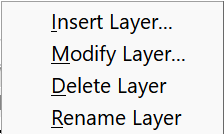
Right-click on the tab of a Layer or left-click in the free area next to the last tab of the selected Layer to open the Layer Context menu.
Insert Layer

In the Context menu, select .
The "Insert Layer" dialog opens.
In the "Name" field, type a name for the new Layer.
In the "Title" field, you can add a title.
In the "Description" field, write what purpose this layer should serve for you.
Below that, set the "Visible", "Printable" and "Locked" properties of the Layer.
Click .
The new Layer is automatically the active Layer.
Modify Layer
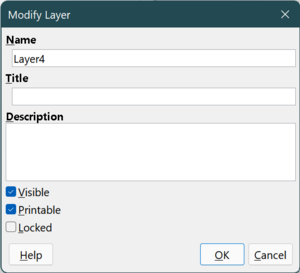
Select in the Context menu .
The "Modify Layer" dialog opens.
Write the desired modifications in the "Name", "Title" or "Description" fields or change the "Visible", "Printable" and "Locked" properties of the Layer.
Click .
The Layer automatically remains the active Layer.
The Layers properties
Visible- shows or hides the content of the selected Layer.Printable- allows printing the Layer or not.Locked- locks the content of the selected Layer or not, i.e. editing the Layer is possible or not.
Possible representations of the Layer labels
The combinations of Layers properties leads to different display of layer labels.
Each Layer has a Layer Context menu.
Right-click on the Layer name to open the menu, or to modify the properties of a Layer, click on the tab with the Layer name and then choose ▸ from the menu.
Selecting brings up the "Modify Layer" dialog.
The properties "Visible", "Printable" and "Locked" can be selected or deselected.
The combination of these three possibilities results in the respective overall state of a Layer.
| 1. | 2. | 3. | ||
|---|---|---|---|---|
| Visible | Visible | Visible | ||
| Printable | Printable | Not Printable | ||
| Unlocked | Locked | Unlocked |
| 4. | 5. | 6. | ||
|---|---|---|---|---|
| Hidden | Hidden | Hidden | ||
| Printable | Printable | Not Printable | ||
| Unlocked | Locked | Unlocked |
Set properties of Layers via keyboard shortcuts

The settings of the "Visible", "Printable" and "Locked" properties of the Layers can also be changed quickly with keyboard shortcuts without menu selection.
To toggle the Layer between Visible / Hidden, press: ⇧ Shift + Click
To toggle the Layer between Locked / Unlocked, press: Ctrl + Click
To toggle the Layer between Printable / Not printable, press: Ctrl + ⇧ Shift + Click
Delete Layer
If you select "Delete Layer", the selected Layer will be deleted.
Rename Layer
If you select "Rename Layer", the tab label will be selected.
Write the new name of the Layer.
You can change the name only of the Layers you created yourself.
Move objects to another layer
You can move one or more objects in Draw to another layer.
Select the objects you want to move.
Click-hold the objects with the mouse until the cursor changes shape.
Then drag the objects to the tab of the layer you want to move them to.
Example: Move object quadrilateral from layer 4 to layer 5:
-
Object selected in layer 4
-
Object dragged to layer 5
Application example "Dummy cemetery"
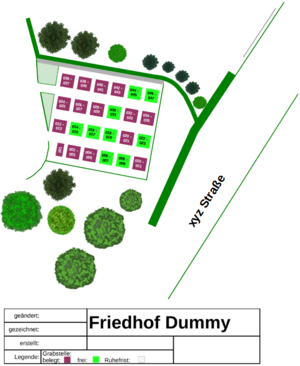
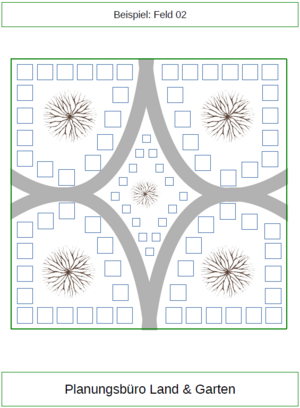
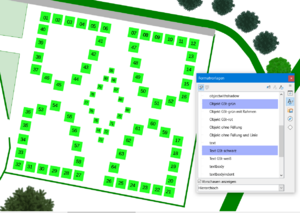
By means of this example, the layer functions are described and treated.
There are two files available for this:
Friedhof Dummy.odg (1)
Arbeitsdatei - Beispiel Feld 02-1.pdf (2)
File 1 contains a grave field that is to be renewed.
File 2 is a plan of a cemetery gardener, showing how the grave field should be renewed.
As the person responsible for file 1, you should now modify file 1 so that it corresponds to the plan of the cemetery gardener.
Clean up the tomb field in file 1
The individual layers are still locked.
Unlock the layer "GrabstellenNrn" ( Ctrl + Click on the layer label ).
Highlight the grave numbers and press Del.
Lock the "GrabstellenNrn" layer ( Ctrl + Click ).
Unlock the "Grabstellen" layer ( Ctrl + Click ).
Select the grave locations and press the Del key.
Lock the "Grabstellen" layer ( Ctrl + Click ).
Insert file 2
Make the "Layout" layer visible ( ⇧ Shift + Click on the layer label ).
And unlock the "Layout" layer ( Ctrl + Click ).
Drag the file 2 (PDF) to the "Layout" layer.
The following actions are performed with the PDF-Plan:
Rotate plan ( 350 degrees ).
Layout, all the way to the back.
Adjust plan size to grave field size.
Lock the "Layout" layer ( Ctrl + Click ).
Redraw grave locations and numbers in the grave field
Unlock the "Grabstellen" layer ( Ctrl + Click ).
Zoom to 65% and position the grave field approximately in the center.
Use the basic shapes to draw the grave sites and adjust them to the plan behind.
Then label the grave sites.
Note the formatting with Styles.
Since the graves are initially unoccupied, they will all be formatted in green.
When you have created all the graves and labels, lock the layers.
Finally, make the "Layout" layer invisible ( ⇧ Shift + Click ).
Further Informations
LibreOffice online help about Layers
Moving Objects to a Different Layer
Work files
"Friedhof Dummy - in work 3.odg"
"Arbeitsdatei - Beispiel Feld 02-1.pdf"
Documentation / Manuals
Here you will find the Documentation / Manuals:
Any questions?
For questions on this topic go to:
Get Involved
Join us today and help us to make it even better!
Donate
LibreOffice is Free Software and is made available free of charge.
Your donation, which is purely optional, supports our worldwide community.
If you like the software, please consider a Donation.
